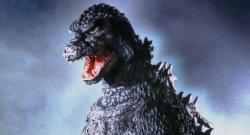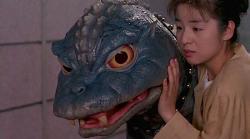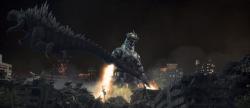Reviews
Gojira tai Mosura / Godzilla and Mothra: The Battle for Earth
Takao Okawara
Japan, 1992
Credits
Review by Sam Bett
Posted on 19 February 2013
Source Sony DVD
Categories The Compleat Godzilla
Much has been written here and elsewhere on how Godzilla’s rampage symbolizes the destruction of urban Japan in World War II, but what about that far more puzzling and enthralling aspect of the monster’s nature: regeneration? Godzilla dies at the end of his eponymous debut; indeed, he dies many times over throughout the series. The reiterative byproduct of this Leviathan theme is the thought that, no matter how each movie ends, the next one will start fresh, unencumbered by the bones and rubble of the last installment’s climactic fight scene.
The enormous egg unearthed by a landslide at the start of Godzilla vs. Mothra brings the symbolic concern of regeneration to the forefront. A similar egg appeared at the start of Mothra, the debut feature for the famous butterfly kaiju, and reappeared a few years later in the remake Mothra vs. Godzilla. These three films share several major structural elements: a typhoon to start the action, the discovery of the gargantuan egg, a meddling corporation’s attempts to commodify the discovery (until it hatches!), and last but not least a pair of fairies clad in miniskirts who serve as interlocutors between the winged insectoid and the human race.
What separates Godzilla vs. Mothra from its predecessors is the domestic arrangement of the humans who interact most closely with these guardian fairies, known in this entry as “The Cosmos” because of their pivotal influence on events of the universe. In the first two variations on the Mothra story, the humans who stay close to the guardian fairies and rely on them to communicate with Mothra are portrayed as members of the press, specifically a male journalist and a female reporter. In Godzilla vs. Mothra, the duo is recast as a divorced couple consisting of Takuya, an Indian Jones type, and his ex-wife Masako, an employee of the state. The schism of domestic security represented by their divorce is abstractly reinforced by the addition of a newcomer to the Godzilla monster pantheon: Battra, the vindictive, evil foil of Mothra that enacts wide-scale destruction upon Japan as punishment for its environmental transgressions.
Battra and Mothra make just as much sense as partners and as foes. One destroys the earth, the other protects it. I am tempted to make a borderline-orientalist reference to the vortexing yet balanced energies of yin and yang, but such a tidy model fails to account for Godzilla once he storms in when Battra and Mothra are in the throes of their post-larval winged fury, causing them to join forces in defense. The economical reason for Godzilla’s intrusion is that he is the headliner and the moneymaker, but the narrative justification is just as compelling. Mothra may be the stronghold of compassion, and Battra may be the force of reckoning, but Godzilla is the engine of untrammeled violence. Much of the drama we have come to expect from Godzilla films - futile tank assaults, panicked board room sessions, control centers walled with massive screens depicting the progress of the beast - all rely on the unpredictable, devastating, and oddly cathartic attacks which are the monster’s trademark. Godzilla gives the Japanese Self-Defense Force, the docked successor to the Imperial Japanese Army, a reason for urgent and decisive action. Indeed, the entire Godzilla corpus can be viewed as an attempt to establish a safe and satisfying target for the lingering martial impulses of a demilitarized democracy founded on the charnel of war.
The main obstacle to the grander artistic, narrative, and social motivations of Godzilla vs. Mothra is that despite the film’s attempt to be serious and mature, the vast tradition of schlock in its wake lends the story an aspect of camp. Even though the fight scenes are justified with a dramatic storyline, after years of watching Godzilla hurl boulders like volleyballs and even teach his son how to breathe fire, some viewers will have difficulty considering his wrath seriously. The road to recovery, however, is always slick and narrow. This film asserts a more serious age for the Godzilla franchise, and in this sense Takuya and Masako’s divorce is emblematic of a tacit admission that the world, for Japan and for Godzilla, is not what it used to be.
More The Compleat Godzilla
-

Godzilla
1954 -

Godzilla Raids Again
1955 -

King Kong vs. Godzilla
1962 -

Mothra vs. Godzilla
1964 -

Ghidorah, the Three-Headed Monster
1964 -

Invasion of Astro-Monster
1965 -

Ebirah, Horror of the Deep
1966 -

Son of Godzilla
1967 -

Destroy All Monsters!
1968 -

All Monsters Attack
1969 -

Godzilla Vs. Hedorah
1971 -

Godzilla vs. Gigan
1972 -

Godzilla vs. Megalon
1973 -

Godzilla vs. Mechagodzilla
1974 -

Terror of Mechagodzilla
1975 -

The Return of Godzilla
1984 -

Godzilla vs. Biollante
1989 -

Godzilla vs. King Ghidorah
1991 -

Godzilla vs. Mothra
1992 -

Godzilla vs. Mechagodzilla
1993 -

Godzilla vs. SpaceGodzilla
1994 -

Godzilla vs. Destoroyah
1995 -

Godzilla 2000
1999 -

Godzilla vs. Megaguirus
2000 -

Godzilla, Mothra and King Ghidorah: Giant Monsters All-Out Attack
2001 -

Godzilla Against Mechagodzilla
2002 -

Godzilla: Tokyo S.O.S.
2003 -

Godzilla: Final Wars
2004
We don’t do comments anymore, but you may contact us here or find us on Twitter or Facebook.



